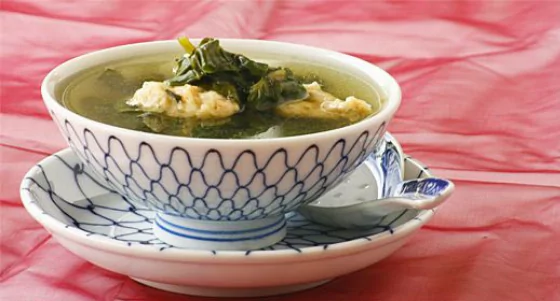Canh tôm rau mong toi, literally a soup made with tôm, or shrimp and mong toi, or spinach, is usually served as a side dish along with steamed jasmine rice and a dish of meat.
Rau mong toi is a tender and sweet leafy vegetable that is unknown in Western cuisine. In Vietnam, it is a staple of lower income people. In fact, there is a saying using this leaf, “Nghèo rot mong toi!”, which approximately translates to “dirt poor”. Like rau muong, another Vietnamese leafy vegetable, it is quite expensive in America. I’ve probably said it in the past: immigrants crave the foods of their childhood and are willing to pay more for the memories. And this soup fits the bill.
1. Info for Vietnamese Spinach and Shrimp Soup (Canh Mong Toi)
- Cook Time: 40 mins
- Total Time: 55 mins
- Servings: 8
- Calories: 280
2. Ingredients for Vietnamese Spinach and Shrimp Soup (Canh Mong Toi)
- 1 quart water
- 3 tablespoons canola oil
- 2 cloves garlic, finely minced
- 2 dozen baby shrimp (about 1 cup), shelled and de-veined
- 1/2 teaspoon tapioca starch
- 1 tablespoon soy sauce
- 1/2 teaspoon red chili powder
- 2 red Thai bird chiles, stemmed
- 1 stalk lemongrass
- 2 shallots, thinly sliced
- 1 (1-inch) chunk daikon turnip, peeled and sliced
- 1 (1-inch) chunk fresh ginger, thinly sliced
- 1/2 white onion, chopped
- 1 (2-inch) chunk rock sugar
- 3/4 teaspoon sea salt (or regular salt)
- 1 teaspoon black pepper, freshly ground
- 1 bunch rau mong toi Vietnamese spinach , about 3 cups
- 1 tablespoon cilantro
- 1 tablespoon green onion, chopped
- 1 dash toasted sesame oil, optional
3. Directions:
3.1 For the lemongrass
Wash the lemongrass. Remove all the white powder from the leaves. Cut the stalk in half and crush it with the back of a chef’s knife.
3.2 Frying the shallots and garlic
Heat the canola oil in a skillet. Fry the shallots in the oil, stirring frequently to prevent the shallots from burning, until the color is evenly golden brown. Reserve the oil. Drain the shallots on paper towels. Set aside.In the same skillet, add the minced garlic and cook until it’s golden. Leave the fried garlic in the oil. Set aside.
3.3 Seasoning the broth
Bring the water to a boil in a small pot. Add the tapioca starch, ginger, lemongrass, chopped onion and fried shallots. Lower the heat to medium-low and cook for about 10 minutes. Add the whole red chiles, daikon and rock sugar. Bring to one more boil, then lower the heat and simmer for 2-3 minutes.
3.4 For the shrimp balls
In a bowl, season the shrimp with 1 teaspoon of fried garlic, sea salt, red chili powder, 1/2 teaspoon of black pepper and 1 teaspoon of cilantro. In a blender or a mini-blender if you have one, blend the shrimp with about 2 teaspoons of the garlic-infused oil. Add a teaspoon of green onion. Form about 1-tablespoon-sized shrimp balls.
3.5 For the rau mong toi
Wash the spinach. Separate the stems from the leaves. Set aside.
3.6 Assembly time
Bring the broth back to a boil. Add the shrimp balls, one at a time. Cook for about 2-3 minutes. Fish out the shrimp balls and set aside on a platter. Add soy sauce and bring the broth back to a boil. Add the rest of the fried garlic and the spinach stems. Cook for a minute then add the rau mong toi leaves. Add the shrimp balls. Turn off the heat. Cover and let the soup sit for about 5 minutes. Remove and discard the lemongrass. Sprinkle the rest of the black pepper.
Serve hot with more cilantro and green onions. Drizzle toasted sesame oil and some nuoc mam to the broth to finish.
Dig in!
4. Tips and advices:
- You can find rau mong toi in most Asian stores. If you don’t have any, you can always use regular spinach.
- Daikon (cu cai trang in Vietnamese) is an Asian turnip that looks like a large white carrot. I use this root when making broth for the natural sweetness it brings.
- I always have garlic-infused oil on hand. I use it a lot to flavor Asian broths, especially vegetarian soups.
- The addition of the sesame oil at the end is optional but brings a nice fragrance to the broth.

